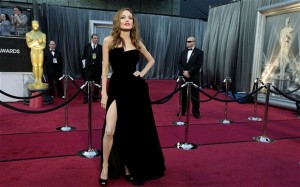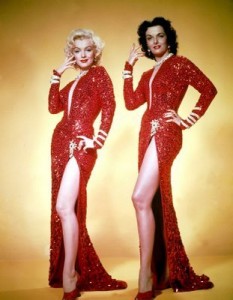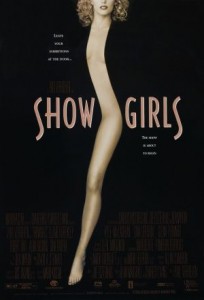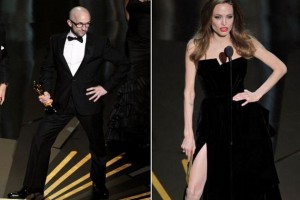A Leg to Stand On
For a long time, I was suspicious that Angelina Jolie wasn’t real. While there may be an actual person named Angelina Jolie, it wasn’t the person in films, on magazine covers or the “candid” shots on the web. In fact, I have never seen the real Angelina Jolie; she is an actor and as such, anytime a camera is trained on her, she disappears and performs “Angelina Jolie.”
Part of this has to do with media oversaturation of course. With a consistent flow of films and tabloid narratives to satiate even the most rabid fan, there is a constant erasure of the Real. Through the sheer repetition of her face and body plastered everywhere – we recognize “Angelina Jolie;” her pose, facial expressions, gait, stance and manner of dress. The candid moments elide into the professional events of the brand known as Angelina Jolie, so much so that it becomes difficult to tell them apart. When she became Lara Croft in the 2001 “Tomb Raiders” film franchise, Jolie was perfectly believable as a fleshly apparition of the video game avatar because we believed knew her off-screen persona as a cold, femme fatale with softness on the side. In her more recent roles as Grendel’s monstrous mother in the CGI animation Beowulf and as the kick-ass ultra spy in Salt, she seems as real as we can possibly see her. That is to say, all of the sultry looks and commanding postures we see of her on-screen, visually matches her off-screen (or more accurately her print) persona. Not to overuse the phrase of the century but there really is no there there with Jolie and that has worked to her advantage. As an actor, the person is the product and whatever privacy is captured as candid moments by the paparazzi’s eye merely adds to the physical vocabulary and persona of the thespian.
Which brings us to the “Leg Incident.”
The image, videos and tweets about this have settled down enough for us to take another look at the leg in question. To review: at the 2012 Academy Awards, Jolie repeatedly posed with her leg out in dramatic fashion throughout the entire spectacle called “The Oscars.” Throughout the red carpet parade and on stage when she presented the award for Best Adapted Screenplay, Jolie worked in a visual quotation. It is the essence of the word “leggy;” as in the “leggy” blonde, brunette, hottie. To put out a single leg, framed by a voluptuous dress is the quintessential mark of the femme fatale. It is a classic Hollywood pose of desire and female sexuality. This is precisely why this pose was so easily recognized, identified, talked about, consumed. For Jolie to make such a visual quotation is her way of saying the most about her public persona without uttering a single word.
This incident is not about who Jolie is but what she is. Angelina Jolie is a persona of her own making. She is our current cultural sign of desire and beauty – both ideal and dangerous. There are many others in the Hollywood machine that fit this bill but Jolie has an acute awareness of what intersects upon her person. To be a movie star means that one’s physical presence, attire, and movement echoes others that have preceded them. Like some kind of legal precedent, those who have embodied the femme fatale in years past leave a visual mark that stays within the consciousness of the audience. These marks have a way of accumulating and builds up over time. When Jolie takes this pose, leg out with arm on hip, it gives the viewer a sense of déjà vu; we’ve clearly been here before, seen that leg stand out. Only last time it wasn’t her leg; it was somebody else’s. When I see Jolie take this stance, I see afterimages of so many others who have struck the same pose: Marilyn Monroe, Jane Russell, Sally Bowles, Salomé and her dance of the seven veils.
Making this pose at the Academy Awards – the paean of the Hollywood film industry – provides a meta-narrative. It intersects the machinery of Hollywood that has worked to devise the filmic femme fatale with the actress who became the persona of the femme fatale. This pose, at that particular moment, is all-encompassing of what has produced, performed and inhabited its meaning.
Of course, with a gesture that is so thoroughly saturated in the cultural zeitgeist, it cannot linger long before it ends in parody. When Jim Rash went up to accept the award along with his co-writers, Alexander Payne and Nat Faxon, he didn’t have much time to say anything. Which leads us to the other leg incident: Jim Rash’s gams. Completely covered in a pant-leg, Rash’s gesture, with Oscar in hand, visually quotes the quotation, providing us with a double entendre.
Such is the life of images and the cultural sign today – full circle in less than five minutes.












I enjoyed your post. I agree that images that actors portray are just that, “images”. We as the public most likely rarely, if ever, see the real person behind the image.
You last sentence is spot on. The rate at which images are shared and become (pop) culturally relevant has increased exponentially. It would be a great topic for another, full post of its own.
Bravo, Christina! Thanks for this enjoyable analysis of celebrity as the ultimate simulacra.